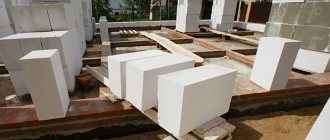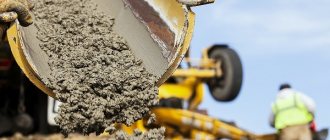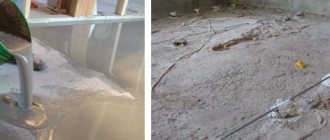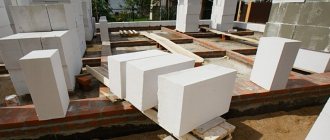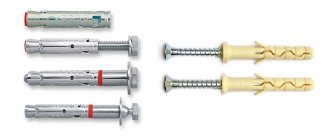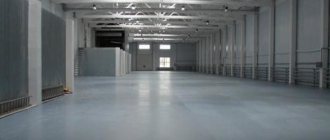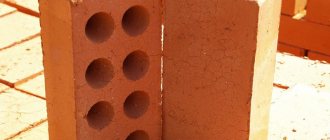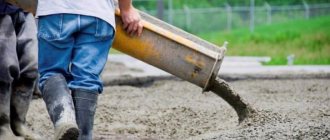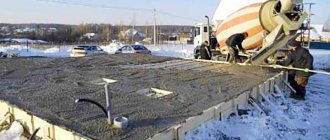If you are planning to build a pool with your own hands, it is necessary that the concrete for the pool has all the qualities necessary for a building material in contact with water, water resistance and frost resistance (since the pool is an outdoor structure). Of course, the concrete must be strong enough for the walls of the reservoir to support its own weight, and its bottom to support the mass of water. All these requirements are most fully met by concrete mortar grade M 300. Its production can be ordered at any concrete mortar unit, but the further story will be of interest only to those who, for one reason or another, are going to prepare the concrete mortar themselves.
Scheme of a concrete pool bowl.
What requirements must the building material meet?
Compared to the installation of strip reinforced concrete structures, swimming pools require a higher quality mixture.
Preference should be given to material created in industrial production in compliance with technical standards.
Pool concrete must contain:
- additional pressure of the mass of water on the walls and base of the structure;
- constant exposure to groundwater and water inside the pool;
- sudden daily temperature changes.
At large factories, special attention is paid to the process of creating the mixture itself. For concrete, sand made from large granules about 2 mm without silt and foreign impurities is suitable.
Crushed stone of medium-sized fractions should be made only from strong natural rocks, such as granite or basalt. The cement must be of a grade not lower than M400 with a shelf life of up to 3 months.
What you need to know first
Before building anything, you need to understand the design features, its advantages and disadvantages, and similar options. Perhaps concrete is far from the most ideal option for you, and installing, for example, a frame pool would be much more rational.
Additional equipment for your comfort
Let's first look at the positive aspects of this material for the construction of artificial reservoirs.
- The most rigid pool structure is made from concrete;
- Freedom of choice. You can build a bowl of any size, depth and shape;
- Possibility of installing any additional equipment. You can install hydromassage, LED lighting, and so on;
- Concrete is the most durable material of all similar ones for the construction of tanks;
- Large selection of finishing and decoration options;
- In general, a concrete pool looks more prestigious than all others.
Now about the disadvantages of this material.
- Extended construction periods. If you build a tank in the spring, then you will only be able to enjoy cool water in it in the middle of summer;
- High price. How much exactly? We will talk about this in more detail below;
- Not the most convenient option to maintain.
- To install it yourself, you need to have construction skills and experience with tools.
As we see, even concrete bowls are not without drawbacks, in principle, like all other options. This option is suitable for those who are not going to save on the construction of an artificial reservoir and want to install the maximum number of additional devices to increase comfort and decoration.
So, if you have decided that a concrete pool is what you need, then read on.
What indicators should be used to choose a concrete mixture?
The most important indicators when choosing a concrete mixture:
Brand of concrete.
Consists of the letter M and numbers indicating the strength of the finished mixture. M300 speaks of the ability to withstand pressure of 300 MPa without loss of performance characteristics. For the base and walls of the pool, use a grade of concrete not lower than M350.- Waterproof. It is designated by the letter W and a number in the range from 2 to 12. The higher the number, the more resistant the mixture is to water, and the more expensive its price. Given the constant contact with groundwater, it is better to use concrete with a water resistance of W6 and higher.
- Frost resistance. This indicator guarantees the preservation of characteristics over several cycles of freezing and defrosting. It is denoted by the letter F and a number that indicates the guaranteed number of such cycles. In practice, the F50 is guaranteed to last for many years, but it is recommended to play it safe and give preference to a brand no lower than F
- There is another indicator of concrete, which is designated as P with a number from 1 to 5. This marking indicates the mobility of the finished mixture. It is regulated by the amount of water in the finished solution. For ease of installation, it is recommended to give preference to concrete P2 or P3.
Often, instead of marking P1-P6, the water-cement ratio parameter is used. In this case, it is worth purchasing a mixture with an index close to 0.5.
When purchasing a concrete mixture for a swimming pool, you should pay attention to the instructions about the content of plasticizers and air-entraining components in its composition. These connections not only improve the quality of the finished monolithic structure, but also protect it from temperature changes and the negative effects of groundwater.
Pool concrete composition
The main components of the mixture, as with any other concrete, are the binder, coarse and fine aggregates, and water. If contact of concrete with water is planned, then special hydrophilic additives are added to the composition. Below we will take a closer look at each of these components.
Binder
It is recommended to use Portland cement grade M400. Most often on the packaging it is designated as follows: CEM I 32.5 N. This is cement without impurities with a normal hardening time. To fill a pool outdoors, it is advisable to choose a higher grade - M500 (CEM I 42.5 N).
Don't buy cement in advance. Some builders prefer to always have a couple of extra bags on hand. But this material has a very short shelf life - 60 days. Moreover, already a month after production it begins to lose its original properties. Relatively speaking, if you buy M500 cement and keep it at home for 30 days, you will receive the M400 grade.
Carefully inspect each bag and lightly knead it with your hands. Good cement should be dry and crumbly. The presence of fossilized fragments in it suggests that it was in contact with water and has already set. Such a binder cannot be used.
Coarse aggregate
According to SP 28.13330.2017 (Protection of building structures from corrosion), crushed stone with a strength grade of at least M800 and water absorption not higher than 2% is used for concrete. The granite variety with grains of 5-10 or 5-20 mm is best suited.
To construct a platform for a frame pool, you can take crushed marble stone. It has low strength and fairly low frost resistance, but it can handle such tasks quite well.
Sometimes pools are built without adding crushed stone to the concrete at all. Instead, they use so-called sand concrete or ordinary cement mortar. Here you need to understand that crushed stone not only fills the volume of the mixture, but also gives the structure additional strength and resistance to temperature changes. Without this component, concrete will have reduced characteristics. By saving on filling a pool, you can lose a large amount on its repair.
Read more about this on the page Crushed stone for concrete.
Fine aggregate
Usually this is sand with grains with a diameter of 2-3 mm. It is better to give preference to the quarry alluvial variety. This material has good adhesion to other components and at the same time is cleaned from foreign impurities. You can also use river sand, but it has more rounded grains.
It is better not to buy sands that are too fine (for example, epoxy or quartz). They are difficult to work with because they precipitate and are unevenly distributed throughout the volume of the future structure.
Another material suitable as a fine aggregate is crushed stone screening of fraction 0-5 or 0-10. It has high strength, tolerates frost well, adheres well to other components of the mixture, and is often cheaper than sand. It is best to choose the granite variety.
On the pages Sand for concrete and Screenings for concrete you will find more detailed information about the choice of these materials.
Water
The cleaner the water, the better. You should not collect it in rivers and lakes. It should have a transparent color and be free of foreign odors.
Plasticizers
These are special additives that make concrete more dense by filling micropores. In addition, the use of plasticizers will allow you to reduce cement consumption and even increase the strength of concrete. You can buy them at most hardware stores; We will not talk about specific manufacturers in this article, since there are a lot of them. But when purchasing, be sure to specify that you need an additive specifically for concrete under the pool.
Fiber fiber should also be added to the concrete. It strengthens the structure of the future structure and prevents the formation of microcracks. Both plasticizers and fiber fiber must be used strictly in accordance with the instructions, which are usually included with the packaging.
Several suitable options
Minimum acceptable characteristics of concrete to be purchased for the purpose of constructing a swimming pool bowl:
- brand - M350;
- class - B25;
- frost resistance - F200;
- water resistance - W6;
- the ratio of water to cement is 0.5.
When constructing large bowls, preference is given to higher quality and more expensive brands of concrete. Ideal indicators for capital construction would be M400 with class B30, frost resistance F300 and water resistance not lower than W8.
To reduce the cost, you can use a construction trick. With a base height of 30 cm and low groundwater, the lower part of the bottom can be filled with concrete grade M100 or M150, and the rest with a more expensive composition.
Building the vertical walls of the bowl
For the walls, you will need to build formwork from moisture-resistant plywood with a thickness of about 21 mm or boards planed on one side (it will be more convenient to work with plywood). In this case, it is necessary to maintain a distance of 40 cm between the vertical slope of the pit and the formwork itself, and also take into account the thickness of the walls (20 cm).
After this, it is necessary to install reinforcement in the formwork and connect it to the “tails” of the horizontal reinforcing layer. The reinforcement spacing and mesh type are the same as for the bottom.
At the next stage, concrete solution is poured into the finished formwork. It also dries in 7 days.
Where and approximately at what cost is it sold?
Ready-made mixtures are purchased from a manufacturer of ready-mixed concrete and cement mortar.
Similar enterprises are found in almost every city with a population of 100 thousand or more.
In larger cities, you can find several manufacturers - this increases natural competition and reduces the final price for the consumer.
The average cost of ready-mixed concrete for swimming pools today is:
- M350 B25 - from 4000 to 6000 per 1 cubic meter. m;
- M400 B30 – from 4150 to 6500 per 1 cubic meter. m.
The price difference is due to the filler used. Cheaper concrete options are supplemented with ordinary quartzite, while the expensive mixture is completed with granite or basalt crushed stone.
Considering the high loads on the final structure, it is not recommended to buy the cheapest option from unverified manufacturers and private carriers.
How to prepare the solution yourself?
Before you save money and start making your own concrete mixture for a swimming pool, it is worth remembering that this process is complicated due to the impossibility of accurately controlling the finished result.
Even if the proportions are observed correctly, there is a risk of obtaining different quality of the mixture during two successive batches . Remains of the mixture in the concrete mixer may be the reason that the first time you get concrete of grade M350, and the next time you get grade M330 or M360.
Concrete mixtures of different brands do not guarantee equal strength around the entire perimeter of the pool bowl.
To create home-made ready-mix concrete grade M400, one 50-kilogram bag of cement will require 4 10-liter buckets of clean mountain sand, 7.5 buckets of granite or quartzite crushed stone.
Add 25 liters of water to the mixture and stir until smooth. The resulting concrete is used both for the bottom of the pool and for its support posts.
Prepare the foundation pit and fill the pillow
Before starting work, it is necessary to think through the drainage system of the pools. To do this, determine where the drain and fill lines will be located.
To dig a pit, it is necessary to apply markings to the ground, which will be 60-80 cm larger in width and length than the dimensions of the pool itself. When calculating the depth of the hole, also take into account the height of the bedding, bottom slab and finishing.
To prevent the walls of the pit from crumbling during work, it is better to make them at a slope of 5 degrees.
At the next stage, you need to lay pipes under the drain (bottom), if you are planning for just such a water intake system. The system is brought out into the pit at an angle.
It is also necessary to lay 2 layers of roofing material or geotextile on the bottom, which will act as a waterproofing material. It is better that the waterproofing extends 20 cm onto the walls of the pit.
After this, a pillow is poured into the bottom of the finished pit and compacted:
- The first layer is 15 cm of sand.
- The second layer is 15 cm of crushed stone.
In the process of compacting the pillow, it is also necessary to form a slope aimed at draining (bottom).
